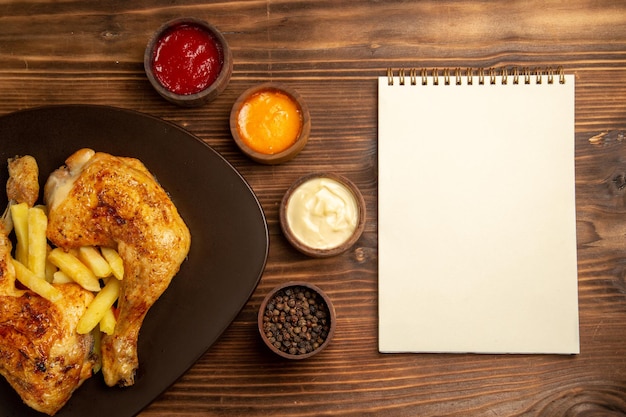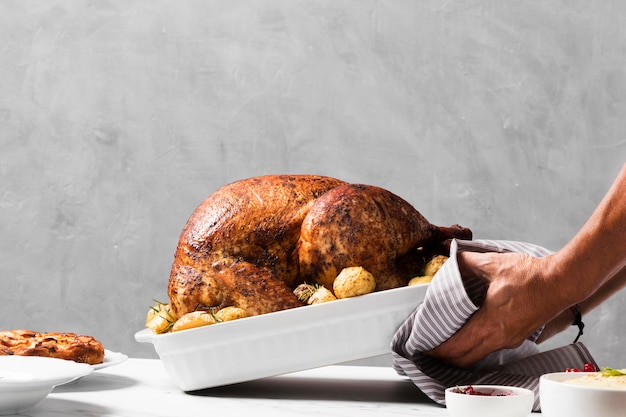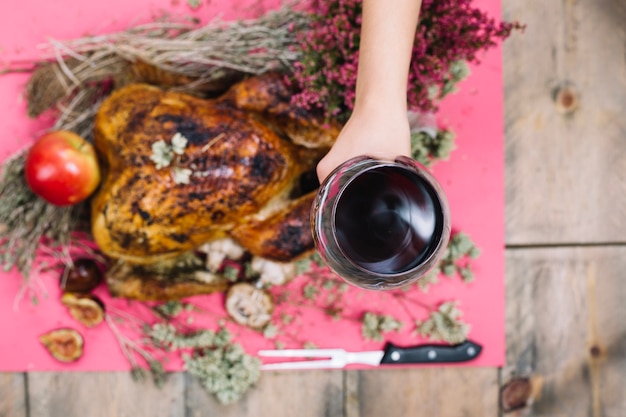Part 1: The Allure of Rotisserie Chicken

What is it about rotisserie chicken that makes it so irresistible? For me, it's the simplicity of it all. Pop the chicken on the spit, set the timer, and let the oven do its magic. No need for flipping, basting every few minutes, or worrying about uneven cooking. It's like having a personal chef in your kitchen, effortlessly whipping up a delicious meal. And the results? Pure perfection. That crispy, golden-brown skin, the tender, juicy meat falling off the bone – it's a symphony of flavors and textures that leaves you feeling utterly satisfied.
Part 2: Choosing the perfect chicken

The journey to a perfect rotisserie chicken begins with selecting the right bird. You want a chicken that's plump and well-shaped, with skin that's not too dry or thin. Avoid any chickens with bruises or cuts, as these can indicate poor handling. Look for a chicken with a pleasant aroma, and the meat should feel firm to the touch.
Size Matters: Selecting the Right Chicken Weight
The size of the chicken you choose depends entirely on how many people you're feeding. A standard whole chicken typically weighs between 3-4 pounds, perfect for a family of 2-4. If you're hosting a larger gathering, opt for a bigger bird, perhaps a 5-6 pound chicken, which can comfortably feed 4-6 people. Don't hesitate to ask your local butcher for advice if you're unsure about the right size for your needs.
Part 3: Your Rotisserie Arsenal: Essential Tools for Success

Now that you have your chicken, it's time to gather your culinary arsenal. The centerpiece of your rotisserie adventure is, of course, the rotisserie oven. There are two main types you can choose from, each with its own set of advantages:
- Free-Standing Rotisserie Ovens: These are stand-alone units, offering complete control over the cooking process. You'll find various models with different features and price points. The advantage here is the flexibility – you can experiment with different cooking times and temperatures, and the dedicated rotisserie function ensures even cooking. If you're a frequent rotisserie chicken cook, this might be the best investment for you.
- Rotisserie Attachments for Your Regular Oven: For a more budget-friendly option, consider a rotisserie attachment for your existing oven. These attachments typically clip onto your oven rack and come with a spit rod that rotates the chicken. While they might not offer the same level of control as a dedicated rotisserie oven, they are a great way to enjoy rotisserie chicken without breaking the bank.
Part 4: Preparing for the Roast: A Step-by-Step Guide
With your chicken and rotisserie oven ready, it's time to get your hands dirty! Here's a step-by-step guide to get you started:
Step 1: The Pre-Cook Prep: A Clean Slate for Flavor
Begin by giving your chicken a thorough rinse under cold water, ensuring all traces of any packaging are removed. Pat it dry thoroughly with paper towels. Now, here's where personal preference comes into play. Some folks like to stuff the chicken cavity with herbs like rosemary or thyme, garlic cloves, or even lemon wedges. I, personally, prefer to keep it simple. A generous seasoning of salt and pepper is all I need to bring out the chicken's natural flavors.
Step 2: Setting Up the Rotisserie: Ensuring Even Cooking
If you're using a free-standing rotisserie oven, refer to the manufacturer's instructions for proper setup. For a rotisserie attachment, ensure it's securely fastened to your oven rack. Now, slide the chicken onto the spit rod, making sure it's balanced and centered. You may need to tie the chicken legs together with kitchen twine to prevent them from flapping around during the cooking process.
Part 5: The Cooking Time Conundrum: Finding the Right Balance
Here's where we delve into the heart of the matter – cooking time. The optimal cooking time for your rotisserie chicken depends on several factors, including:
- The Size of the Chicken: A larger chicken will naturally take longer to cook than a smaller one.
- The Type of Rotisserie Oven: Some ovens are hotter than others, which can influence the cooking time.
- Your Personal Preference: Do you prefer a crispier skin or a juicier interior? Adjusting the cooking time can help achieve your desired results.
General Cooking Time and Temperature Guidelines: A Starting Point
While every oven and chicken is unique, here are some basic guidelines to get you started. Remember, always check the internal temperature of the chicken with a meat thermometer for the most accurate results.
| Chicken Weight | Cooking Time (Approximate) | Internal Temperature |
|---|---|---|
| 3-4 pounds | 1 hour to 1 hour and 15 minutes | 165°F (74°C) |
| 4-5 pounds | 1 hour and 15 minutes to 1 hour and 30 minutes | 165°F (74°C) |
| 5-6 pounds | 1 hour and 30 minutes to 1 hour and 45 minutes | 165°F (74°C) |
A Note on Timing: Undercooked is Better Than Overcooked
It's always safer to slightly undercook the chicken than overcook it. You can easily pop it back in the oven for a few minutes if needed. But overcooked chicken can become dry and tough, which is a culinary crime we want to avoid at all costs.
Part 6: Resting for the Best Results: Letting the Chicken Settle In
Once the cooking timer has sounded and your chicken has reached the desired internal temperature, resist the urge to carve it immediately. Allow the chicken to rest for 10-15 minutes before carving. This might seem like an unnecessary step, but trust me, it's crucial for achieving the best results. During this resting period, the juices redistribute throughout the meat, resulting in a more tender and juicy chicken.
Part 7: Serving Time: A Rotisserie Chicken Feast
Now comes the moment of truth – serving your delicious creation! Rotisserie chicken is a culinary chameleon, adapting beautifully to various sides and serving styles. Consider pairing it with classic accompaniments like roasted vegetables, crispy potatoes, fresh salads, or fluffy rice. It's also a perfect base for sandwiches, wraps, or even salads. Get creative and let your taste buds guide you!
Part 8: The Art of Rotisserie Perfection: Tips for Success
Here are a few extra tips to elevate your rotisserie chicken game and ensure a truly memorable experience:
- Basting: For an extra layer of flavor and moisture, baste the chicken with butter or oil during cooking. However, be careful not to baste too often, as this can make the skin soggy.
- Space is Key: Make sure there's enough space in the oven for the chicken to rotate freely without bumping into other dishes. If you're cooking additional side dishes, ensure they are positioned away from the chicken to prevent uneven cooking.
- Keep a Watchful Eye: While rotisserie chicken is essentially a set-it-and-forget-it dish, it's always a good idea to check on the chicken periodically, especially towards the end of the cooking time. You wouldn't want to end up with a burnt bird, would you?
Part 9: Leftover Magic: Transforming Rotisserie Chicken into New Delights
You've cooked a beautiful rotisserie chicken, and it's time to enjoy the spoils. But what about those glorious leftovers? Don't fret! There are countless ways to transform leftover rotisserie chicken into new culinary adventures. Here are a few ideas to inspire you:
- chicken salad: Chop up the leftover chicken and combine it with mayonnaise, celery, onion, and your favorite seasonings. Serve it on bread, crackers, or a bed of lettuce for a satisfying and quick lunch or snack.
- Chicken Soup: Don't throw away those bones! Use them to create a flavorful chicken stock. Then, shred the leftover chicken and add it to the stock for a heartwarming and comforting chicken soup.
- Chicken Enchiladas: Shred the leftover chicken and use it as a filling for enchiladas. Top them with your favorite sauce and cheese for a cheesy and satisfying meal.
FAQs: Addressing Your Rotisserie Chicken Queries
Here are some commonly asked questions about rotisserie chicken, answered to help you navigate this culinary adventure with confidence:
1. Can I Cook a Frozen Rotisserie Chicken?
It's generally not recommended to cook a frozen rotisserie chicken. The best practice is to thaw the chicken thoroughly in the refrigerator overnight before cooking. If you're in a pinch, you can defrost the chicken in cold water, ensuring it's fully thawed before placing it on the rotisserie.
2. How Do I Know If My Rotisserie Chicken is Done?
The most accurate way to determine if your rotisserie chicken is fully cooked is to use a meat thermometer. Insert the thermometer into the thickest part of the thigh, and ensure it reaches at least 165°F (74°C). You can also check if the juices run clear when you pierce the chicken with a fork.
3. What If My Rotisserie Chicken is Dry?
If your rotisserie chicken is a bit dry, it's likely due to overcooking. While basting during cooking can help prevent dryness, if it's already dry, there are a few ways to salvage the situation. You can shred the chicken and add it to a soup, stew, or casserole, where the added liquid can help rehydrate the meat.
4. Can I Roast a Chicken in the Oven Without a Rotisserie?
Absolutely! If you don't have a rotisserie oven, you can still enjoy a delicious roasted chicken. Simply place the chicken on a rack in a roasting pan, breast side up, and roast it in a preheated oven at 350°F (175°C) for approximately 1 hour and 15 minutes for a 3-4 pound chicken. Basting with butter or oil during cooking can help keep the meat moist and flavorful.
5. What's the Best Way to Store Leftover Rotisserie Chicken?
Store leftover rotisserie chicken in an airtight container in the refrigerator for up to 3-4 days. You can also freeze the chicken for up to 2-3 months. Before freezing, wrap the chicken tightly in plastic wrap or aluminum foil to prevent freezer burn and maintain its freshness.
So there you have it, my dear culinary companions – your complete guide to rotisserie chicken success. Now, go forth and conquer the art of crispy skin and succulent meat!
Everyone is watching

Perfect Rice Every Time: The Ultimate Guide to Cooking Rice
Cooking TipsAs a self-proclaimed foodie, I've always been a bit obsessed with rice. It's the foundation of countless cuisi...

Prime Rib Roast Cooking Time Chart: Per Pound Guide
Cooking TipsPrime rib roast. Just the name conjures images of lavish dinners, crackling fires, and hearty laughter. It’s ...

The Ultimate Guide to Cooking Asparagus: Tips, Techniques, and Recipes
Cooking TipsAsparagus. The mere mention of this spring delicacy conjures up images of vibrant green spears, crisp and burs...

Ultimate Guide to Cooking the Perfect Thanksgiving Turkey
Cooking TipsThanksgiving. Just the word conjures up images of overflowing tables laden with delicious food, the scent of r...

How Long to Bake Potatoes in the Oven (Perfect Every Time)
Cooking TipsBaked potatoes are a staple in my kitchen. They're incredibly versatile, delicious, and surprisingly easy to m...
